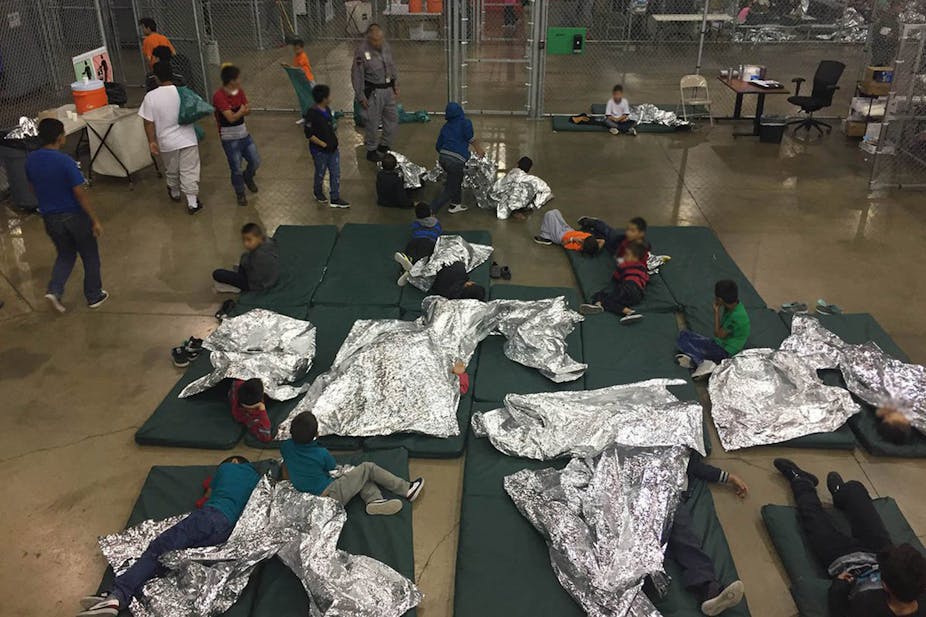After weeks of mounting pressure, Donald Trump signed an executive order on June 20 to stop his administration’s policy of separating migrant children from their parents at the southern border of the US. Putting the policy into a wider historical context of state-sanctioned policies of child separation helps to understand why some aspects of it were remarkably distinctive – and caused such international outrage.
From the closing decades of the 19th century, an array of policies emerged across the Anglophone world which challenged assumptions about parents’ inalienable rights to their children. A transnational child protection movement led to the formation of child protection societies, beginning with the New York Society for the Prevention of Cruelty to Children in 1875. New legislation followed in the UK, Canada and Australia allowing the removal of children from parents on grounds of cruelty or neglect.
Alongside this, various forms of welfare intervention developed which removed children from their families, with varying degrees of parental consent. This was done on the basis that children would be placed in new environments better suited to their moral, religious and civic development.
These included policies that sought to place children from indigenous communities in institutions in which they could be “Christianised and civilised”. This led to “Indian” residential schools in Canada and the United States. It also sparked programmes which moved unaccompanied children around within their own country, such as the American “orphan trains”, or to other countries, such as the UK child migration schemes where children were sent to Canada or Australia. Other forms of residential incarceration were also introduced, such as the industrial school system in Ireland.

Sacred bonds broken
These initiatives continued just as ideas of the sacred emotional ties between parent and child were becoming more pervasive in society. However, state-sanctioned policies of family separation, usually delivered by leading charities and religious organisations, operated on the basis that such sacred bonds need not be respected for certain types of parents. These extended far beyond cases of child cruelty to judgements made about the suitability of a parent based on their ethnicity, class, lifestyle or marital status.
While the history of these welfare initiatives is complex and diverse, two common characteristics stand out. First, moral justifications were made for them with claims that the child’s social background – including the relationship with their parents – was a harmful influence and that removal of the child was necessary for saving them as a future citizen. Moral symbolism of the polluting home and the rescue of the child from darkness to light proliferated in publicity materials and public statements of support for their work.
Second, in almost all cases – apart from in the US – such welfare initiatives have become a focus of national shame and regret, expressed through inquiries and truth commissions, public apologies and, in some cases, financial compensation.
In some respects the current policy by the Trump administration reflects aspects of this history. Similar dehumanising moral language about parents used to justify child separation in the past has been reflected in statements made by US officials that describe migrants as criminals. As Trump put it in one tweet, they threaten to “infest” American society.
Scale and harm
In other respects, there are striking differences. The sheer scale of reported separations – 2,300 migrant children are said to have been removed from parents in six weeks – is extraordinary compared to previous state-sanctioned policies of separation. If rates of removal had continued at this level, the policy would have led to numbers of separations of children from parents in five years that other historical policies took several decades to realise.
Compared to historical welfare interventions, this US policy also lacked any moral claim that the separations were for the good of the child. It functioned simply as a punitive measure against immigration, ignoring evidence of the traumatic effects of separation from parents for children. This may help to explain why it has received much greater public censure than previous policies which received varying degrees of public toleration or support on the basis of claims that they benefited the children involved.
Another contrast concerns the speed and extent to which public opposition to the policy grew. Historically, state-sanctioned policies of child separation have often faced public criticisms and periodic scandals. But despite evidence of their harmful effects the policies usually persisted for decades, in part because public opinion has too readily deferred to the positive moral intent that governments and voluntary organisations claimed had driven the separations.
An example of this was the finding of the Bryce Report of 1907 which revealed that in the Indian residential schools in Canada, the mortality rate of indigenous children from tuberculosis was 24% – double that of the wider indigenous population. Support for the missionary aims of this work meant, however, that far from being closed down the residential school system subsequently expanded and did not undergo any significant reforms until the 1960s.
By comparison, public opposition to the Trump administration’s family separation policy has grown rapidly through print and broadcast media no longer characterised by such deference. Social media has also played an integral part in this process. Visual records of previous state-sanctioned policies of child separation were usually made by those supporting them, such as publicity photographs of British child migrants smiling and waving into the camera before setting off overseas.
By contrast, the widespread circulation of images and audio files capturing the distress of migrant children has played an important role in mobilising public opinion against the moral symbolism that dehumanises migrants and legitimises such separations.
Judged in this historical context, if Trump’s policy proves shortlived, it is because its exceptional scale and brutality lacked sufficient moral legitimacy in American public opinion to outweigh the powerful images of children’s suffering circulated in the media. For those children who have already been separated from parents – uncertain how they will be reunified – this will come as little consolation.

